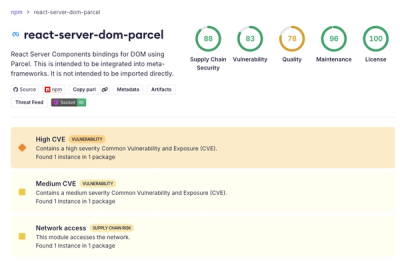
Security News
Deno 2.6 + Socket: Supply Chain Defense In Your CLI
Deno 2.6 introduces deno audit with a new --socket flag that plugs directly into Socket to bring supply chain security checks into the Deno CLI.
lmsystems
Advanced tools
The LMSystems SDK provides flexible interfaces for integrating and executing purchased graphs from the LMSystems marketplace in your Python applications. The SDK offers two main approaches:
Get started quickly with our interactive Colab notebook:
This notebook provides a hands-on introduction to the LMSystems SDK with ready-to-run examples.
Install the package using pip:
pip install lmsystems==1.0.8
The client SDK provides direct interaction with one LMSystems graphs (e.g. Deep Research Agent):
from lmsystems import (
SyncLmsystemsClient,
APIError
)
import os
def main():
# Check for required environment variables
api_key = os.environ.get("LMSYSTEMS_API_KEY")
# Initialize client
client = SyncLmsystemsClient(
graph_name="groq-deep-research-agent-51",
api_key=api_key
)
try:
# Create a new thread
thread = client.threads.create()
print(f"Created thread with status: {client.get_thread_status(thread)}")
# Example 1: Using default environment variables
for chunk in client.stream_run(
thread=thread,
input = {
"research_topic":"what are the best agent frameworks for building apps with llms?"
},
config = {
"configurable": {
"llm": "",
"tavily_api_key": "",
"groq_api_key": ""
}
},
stream_mode=["messages", "updates"]
):
print(f"Received chunk: {chunk}")
# Example: Check final thread status
final_status = client.get_thread_status(thread)
print(f"Final thread status: {final_status}")
except APIError as e:
print(f"API Error: {str(e)}")
except Exception as e:
print(f"Unexpected error: {str(e)}")
if __name__ == "__main__":
main()
For integration with other Langgraph apps, you can plug Purchased Graphs in as a single node:
from lmsystems.purchased_graph import PurchasedGraph
from langgraph.graph import StateGraph, START, MessagesState
import os
from dataclasses import dataclass
@dataclass
class ResearchState:
research_topic: str
api_key = os.environ.get("LMSYSTEMS_API_KEY")
def main():
# Initialize our purchased graph (which wraps RemoteGraph)
purchased_graph = PurchasedGraph(
graph_name="groq-deep-research-agent-51",
api_key=api_key,
default_state_values = {
"research_topic":""
},
config = {
"configurable": {
"llm": "llama-3.1-8b-instant",
"tavily_api_key": "",
"groq_api_key": ""
}
},
)
# Create parent graph and add our purchased graph as a node
builder = StateGraph(ResearchState)
builder.add_node("purchased_node", purchased_graph)
builder.add_edge(START, "purchased_node")
graph = builder.compile()
# Use the parent graph - invoke
result = graph.invoke({
"research_topic": "what are the best agent frameworks for building apps with llms?"
})
print("Parent graph result:", result)
# Use the parent graph - stream
for chunk in graph.stream({
"research_topic":"what are the best agent frameworks for building apps with llms?"
}, subgraphs=True): # Include outputs from our purchased graph
print("Stream chunk:", chunk)
if __name__ == "__main__":
main()
The SDK now automatically handles configuration through your LMSystems account. To set up:
Your configured API keys and settings will be automatically used when running graphs - no need to include them in your code!
Note: While configuration is handled automatically, you can still override settings programmatically if needed:
# Optional: Override stored config
config = {
"configurable": {
"model": "gpt-4",
"openai_api_key": "your-custom-key"
}
}
purchased_graph = PurchasedGraph(
graph_name="github-agent-6",
api_key=os.environ.get("LMSYSTEMS_API_KEY"),
config=config # Optional override
)
Store your LMSystems API key securely using environment variables:
export LMSYSTEMS_API_KEY="your-api-key"
LmsystemsClient.create(
graph_name: str,
api_key: str
)
Parameters:
graph_name: Name of the graph to interact withapi_key: Your LMSystems API keyMethods:
create_thread(): Create a new thread for graph executioncreate_run(thread, input): Create a new run within a threadstream_run(thread, run): Stream the output of a runget_run(thread, run): Get the status and result of a runlist_runs(thread): List all runs in a threadPurchasedGraph(
graph_name: str,
api_key: str,
config: Optional[RunnableConfig] = None,
default_state_values: Optional[dict[str, Any]] = None
)
Parameters:
graph_name: Name of the purchased graphapi_key: Your LMSystems API keyconfig: Optional configuration for the graphdefault_state_values: Default values for required state parametersMethods:
invoke(): Execute the graph synchronouslyainvoke(): Execute the graph asynchronouslystream(): Stream graph outputs synchronouslyastream(): Stream graph outputs asynchronouslyThe SDK provides specific exceptions for different error cases:
AuthenticationError: API key or authentication issuesGraphError: Graph execution or configuration issuesInputError: Invalid input parametersAPIError: Backend communication issuesExample error handling:
from lmsystems.exceptions import (
LmsystemsError,
AuthenticationError,
GraphError,
InputError,
APIError,
GraphNotFoundError,
GraphNotPurchasedError
)
try:
result = graph.invoke(input_data)
except AuthenticationError as e:
print(f"Authentication failed: {e}")
except GraphNotFoundError as e:
print(f"Graph not found: {e}")
except GraphNotPurchasedError as e:
print(f"Graph not purchased: {e}")
except GraphError as e:
print(f"Graph execution failed: {e}")
except InputError as e:
print(f"Invalid input: {e}")
except APIError as e:
print(f"API communication error: {e}")
except LmsystemsError as e:
print(f"General error: {e}")
The SDK supports different streaming modes through the StreamMode enum:
from lmsystems import StreamMode
# Stream run with specific modes
async for chunk in client.stream_run(
thread=thread,
input=input_data,
stream_mode=[
StreamMode.MESSAGES, # Stream message updates
StreamMode.VALUES, # Stream value updates from nodes
StreamMode.UPDATES, # Stream general state updates
StreamMode.CUSTOM # Stream custom-defined updates
]
):
print(chunk)
Available stream modes:
StreamMode.MESSAGES: Stream message updates from the graphStreamMode.VALUES: Stream value updates from graph nodesStreamMode.UPDATES: Stream general state updatesStreamMode.CUSTOM: Stream custom-defined updatesFor support, feature requests, or bug reports:
FAQs
SDK for integrating purchased graphs from the lmsystems marketplace.
We found that lmsystems demonstrated a healthy version release cadence and project activity because the last version was released less than a year ago. It has 1 open source maintainer collaborating on the project.
Did you know?

Socket for GitHub automatically highlights issues in each pull request and monitors the health of all your open source dependencies. Discover the contents of your packages and block harmful activity before you install or update your dependencies.

Security News
Deno 2.6 introduces deno audit with a new --socket flag that plugs directly into Socket to bring supply chain security checks into the Deno CLI.

Security News
New DoS and source code exposure bugs in React Server Components and Next.js: what’s affected and how to update safely.

Security News
Socket CEO Feross Aboukhadijeh joins Software Engineering Daily to discuss modern software supply chain attacks and rising AI-driven security risks.